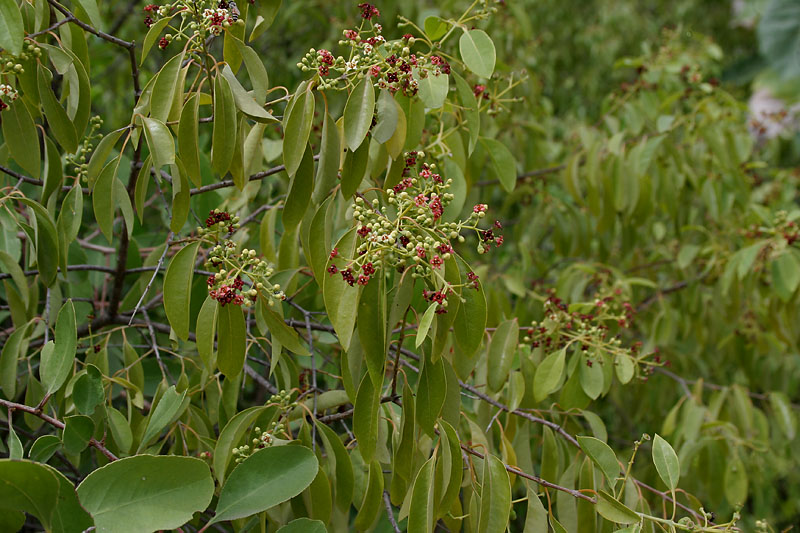
From Wikimedia, J.M.Garg, CC BY-SA 4.0
Timor-Leste
Sandalwood
Santalum album

From Wikimedia, J.M.Garg, CC BY-SA 4.0
General Description / Cultural Significance
Sandalwood, belonging to the Santalum genus, is a small, aromatic evergreen tree native to tropical regions like Timor-Leste. Typically reaching heights of 13 to 30 feet, sandalwood trees have bold, green, lance-shaped leaves that are leathery in texture, typical of evergreens. Its bark is light brown, smooth, and dense, while the heartwood—located within the inner trunk—is the primary source of its sought-after fragrance. Sandalwood flowers are small, yellowish, and share a subtler version of the tree’s characteristic scent. The heartwood is known for its rich, sweet, and woody aroma, prized globally and commonly used in perfumery, incense, and cosmetics.
In Timor-Leste, sandalwood, known locally as “Ai-Kamelan” or “Ai-Kafé,” is deeply woven into the cultural and spiritual landscape. It is revered as a symbol of purity, wisdom, and peace. The burning of sandalwood incense is thought to foster an atmosphere of tranquility, connecting those nearby to higher spiritual realms and granting blessings of prosperity and future success. This traditional use of sandalwood, particularly in ceremonies and ancestral rituals, reflects the tree’s sacred status, as it is believed to bring protection and blessings from the ancestors.
Sandalwood also holds significant value in traditional Timorese medicine. The wood is often ground into a paste and applied to treat skin conditions, while its essential oil is inhaled or applied to the chest to alleviate respiratory ailments. Additionally, sandalwood products have historically been reserved for elite members of Timorese society, symbolizing social status and prosperity. Items made from sandalwood, such as carved artifacts and ceremonial objects, continue to play an important role in marriage dowries and other ceremonial exchanges, marking it as a valued cultural heritage asset.
The distinct fragrance and medicinal properties of sandalwood are attributed to its complex chemical profile. Some of the key compounds include α-Santalol, the anti-inflammatory effects β-Santalol, sesquiterpenes Santalene and Santalenone which contribute antimicrobial properties, and antioxidant Teresantalol.
Climate Change / Conservation Status
In recent years, the high demand for sandalwood heartwood in perfumes, incense, and other scent-based products has led to overharvesting, posing a significant threat to its sustainability. Timor-Leste, like other regions with limited natural resources, faces challenges in managing the remaining sandalwood populations due to overcultivation and exploitation. The depletion of mature sandalwood trees not only threatens this species but also endangers the ecosystem services it provides.
In response, conservation organizations are collaborating with local governments to implement sustainable harvesting practices and promote replanting initiatives. By prioritizing sustainable sandalwood management, these efforts aim to preserve Timor-Leste’s natural heritage and ensure that future generations can benefit from this culturally and economically valuable resource.
Sandalwood in Timor-Leste is more than just a tree—it embodies cultural heritage, spiritual beliefs, and medicinal practices. As conservation efforts work to protect this valuable species, there is a growing awareness of sandalwood’s role in local identity and environmental health. Sustainable management and revitalization efforts are essential to safeguard sandalwood’s legacy for future generations.
Alternate Names
Chandan
Candana
Senden
Byakudan
Sources
The Editors of Encyclopedia Britannica. “Sandalwood.” Encyclopædia Britannica, Encyclopædia Britannica, inc., 30 Sept. 2024, www.britannica.com/plant/sandalwood. Accessed 6 Nov. 2024.
Hawaii), Jesse Adams (University of, and Mersedeh Pejhanmehr (University of Hawaii). “The IUCN Red List of Threatened Species.” IUCN Red List of Threatened Species, IUCN, 13 May 2016, www.iucnredlist.org/species/62929/95817407. Accessed 7 Nov. 2024.
Petite Histoire. “Sandalwood, Fragrance of the Gods: A Comprehensive Guide to the History, Harvesting, and Distillation Process of a Beloved an Exotic Wood.” Petite Histoire: Sandalwood, 13 July 2023, nyc.ph/blogs/inspiration/sandalwood-fragrance-of-the-gods-a-comprehensive-guide-to-the-history-harvesting-and-distillation-process-of-a-beloved-an-exotic-wood?srsltid=AfmBOooBGRozoGCVHtC_fbFy1qFVfUtEHUZ0PTYbkNcBWcBP6-sPSZVp.
Rajsmita, Bhattacharjee, and Vinay Keshavamurthy. “Re-Discovering Sandalwood: Beyond Beauty and Fragrance.” Indian Dermatology Online Journal, U.S. National Library of Medicine, 2019, pmc.ncbi.nlm.nih.gov/articles/PMC6536050/#:~:text=The%20heartwood%20is%20considered%20sacred,part%20of%20meditation%20and%20prayer. Accessed 6 Nov. 2024.

